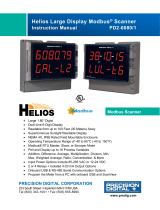ProtEX PD8-6080/PD8-6081 Explosion-Proof Modbus
®
Scanner Instruction Manual
3
Table of Contents
Table of Contents ----------------------------------------- 3
Table of Figures ------------------------------------------- 4
Introduction ------------------------------------------------- 5
Ordering Information ------------------------------------ 6
Specifications ---------------------------------------------- 7
Operating Modes ---------------------------------------------- 7
Master & Snooper Settings --------------------------------- 7
PV Settings ------------------------------------------------------ 7
Display Settings ------------------------------------------------ 7
Math Functions ------------------------------------------------- 8
Serial Communications -------------------------------------- 8
General ------------------------------------------------------------ 8
Relays ------------------------------------------------------------- 9
Isolated 4-20 mA Transmitter Output ------------------- 9
Digital Inputs & Outputs ------------------------------------- 9
Dual Process Input ------------------------------------------ 10
MeterView Pro ------------------------------------------------ 10
Product Ratings and Approvals; ----------------------- 11
Compliance Information ------------------------------ 12
Safety ------------------------------------------------------------ 12
Electromagnetic Compatibility -------------------------- 12
Safety Information -------------------------------------- 13
Installation ------------------------------------------------ 13
Unpacking ------------------------------------------------------ 13
Pre-Installed Conduit/Stopping Plug ------------------ 14
Mounting ------------------------------------------------------- 14
Cover Jam Screw -------------------------------------------- 14
Transmitter Supply Voltage Selection (P+, P-) ---- 14
Connections --------------------------------------------------- 15
Required & Factory Wired Connection --------------- 15
Connectors Labeling -------------------------------------- 16
Power Connections --------------------------------------- 16
Serial Communications Connections ----------------- 17
Using PROVU Serial Adapters --------------------------- 19
F4 Digital Input Connections ---------------------------- 19
Relay Connections ---------------------------------------- 19
Switching Inductive Loads ------------------------------- 20
4-20 mA Output Connections --------------------------- 20
Analog Output Transmitter Power Supply ----------- 20
Interlock Relay Feature ---------------------------------- 21
Analog Input Signal Connections ---------------------- 21
Digital I/O Connections ----------------------------------- 23
External Switch Contacts -------------------------------- 23
Setup and Programming------------------------------ 24
Overview -------------------------------------------------------- 24
SafeTouch
®
Buttons ---------------------------------------- 24
Front Panel Buttons and Status LED Indicators -- 25
ScanView Software ----------------------------------------- 26
ScanView Installation ------------------------------------- 26
Display Functions & Messages ------------------------- 27
Menu Navigation Tip ---------------------------------------- 30
Setting Numeric Values ----------------------------------- 30
Main Menu ----------------------------------------------------- 30
Serial Communications (serial) ----------------------- 31
Scanner Mode Selection ---------------------------------- 32
Operating Modes (nmode) --------------------------------- 32
How to Enable Process Variables (PVs) ------------- 32
Master Mode (nmastr) ----------------------------------- 33
Snooper Mode (Snoopr) ----------------------------------- 34
How to Select 5 or 6-Digit Registers ------------------ 35
Slave Mode (Slave) -------------------------------------- 35
Setting Up the Scanner (setup) ------------------------- 36
Setting Up the Process Variables (PVs) (pv setup)
----------------------------------------------------------------- 37
Setting the Display Decimal Point (disp.dp)--------- 37
Setting the Float Decimal Point (Flot..dp) ----------- 37
Scaling the PV Display Values (sCale) -------------- 38
Scale Menu ------------------------------------------------- 38
Setting Up the Displays (dsplay setup) ------------- 39
Display Line 1 Parameters (Line 1 dsplay) ------ 39
Display Line 2 Parameters (Line 2 dsplay) ------ 39
Display Intensity (d-IntY) ------------------------------- 39
Display Line 1 Menu (Line 1 dsplay) -------------- 40
Display Line 2 Menu (Line 2 dsplay) -------------- 41
Setting the Tags (tAg) & Units (units) -------------- 42
Application Example 1 ----------------------------------- 42
Application Example 2 ----------------------------------- 45
Setting the Relay Operation (relay) ------------------ 46
Relay Setup Menu (relay setup) ------------------- 46
Setting the Relay Action (act 1) ------------------------ 47
Programming Set (set) & Reset (rst) Points -------- 47
Setting Fail-Safe Operation (failsf) -------------------- 47
Programming Time Delay (delay) --------------------- 47
Relay Action for Communications Break (break) -- 48
Relay Action for Loss of 4-20 mA Input (Loop Break)
----------------------------------------------------------------- 48
Relay and Alarm Operation Diagrams ---------------- 48
High Alarm Operation (Set > Reset) ------------------ 48
Low Alarm Operation (Set < Reset) ------------------ 48
High Alarm with Fail-Safe Operation (Set > Reset)
----------------------------------------------------------------- 49
Low Alarm with Fail-Safe Operation (Set < Reset) 49
Pump Alternation Control Operation ------------------ 49
Relay Sampling Operation ------------------------------ 50
Relay Operation After Communications Break ---- 50
Signal Loss or Loop Break Relay Operation ------- 51
Time Delay Operation ------------------------------------ 51
Relay Operation Details ----------------------------------- 52
Overview ----------------------------------------------------- 52
Relays Auto Initialization -------------------------------- 52
Fail-Safe Operation (failsf) -------------------------- 52
Front Panel LEDs ----------------------------------------- 52
Latching and Non-Latching Relay Operation ------- 53
Non-Latching Relay (Auto) ----------------------------- 53
Non-Latching Relay (A-man) ------------------------- 53
Latching Relay (LatcH) ---------------------------------- 53
Latching Relay (Lt-Clr) --------------------------------- 53
Acknowledging Relays ----------------------------------- 54
Pump Alternation Control Applications (Altern) -- 54
Setting Up the Interlock Relay (Force On) Feature 55
Scaling the 4-20 mA Analog Output (Aout) --------- 56
Setting Up the Password (pass) ------------------------ 57
Protecting or Locking the Scanner -------------------- 57
Making Changes to a Password Protected Scanner
----------------------------------------------------------------- 57
Disabling Password Protection ------------------------ 57
Advanced Features Menu -------------------------------- 58
Advanced Menu Navigation Tips ---------------------- 58



























